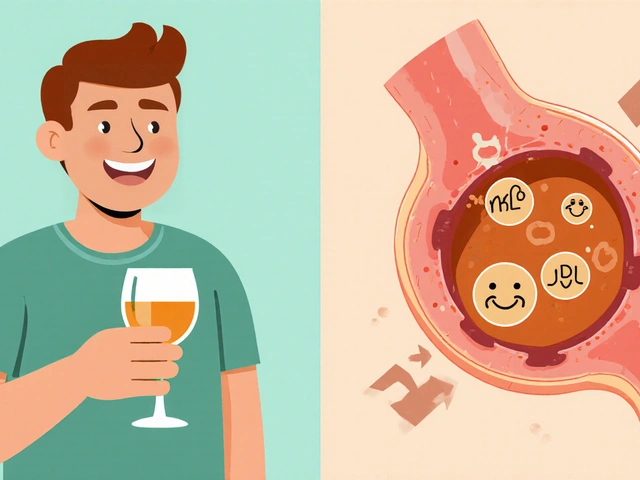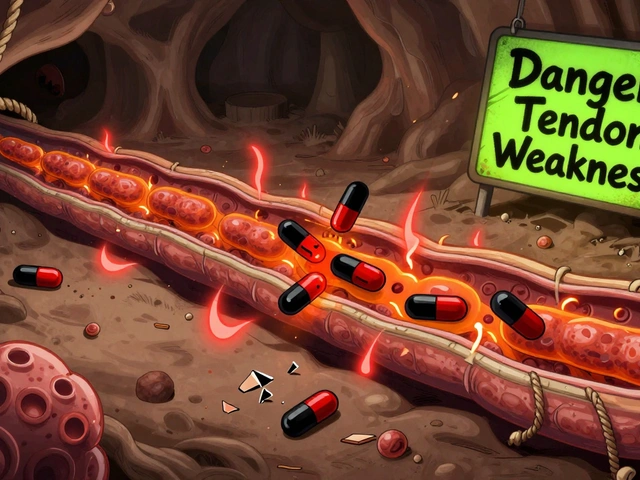If you ever wondered how a tiny pill can pack such a punch against surprise pregnancies, meet Mircette. Even though there are dozens of contraceptive options on the market, Mircette’s low-dose hormone balance and extra flexibility put it on a lot of doctors’ short lists. But what actually sets it apart in the sea of birth control brands? Here’s the real deal—what to expect, what could throw you for a loop, and why Mircette might be the low-drama friend you didn’t know you needed in your medicine cabinet.
How Mircette Works: Hormones in Sync
Mircette isn’t just another pill—it’s a combination oral contraceptive, mixing two hormones: ethinyl estradiol (an estrogen) and desogestrel (a progestin). These stop your body from releasing an egg (that’s ovulation). No egg, no fertilization. But that’s not all. The pill also messes with cervical mucus, making it thicker, so sperm have a much harder time reaching any egg that might still slip by. Plus, it changes the lining of your uterus a bit—so if anything did somehow get fertilized, it wouldn’t have an easy time settling in.
One thing Mircette does differently: its schedule. You get 21 active pills with hormones, followed by 2 hormone-free pills, and then 5 pills with only a tiny bit of estrogen. That little trick helps a lot of users avoid nasty headaches that sometimes pop up in the ‘pill-free’ gap of other brands. The low dose of estrogen also tends to keep other side effects mild compared to higher-dose pills.
Guess what? Studies show that, when used exactly as prescribed, Mircette is over 99% effective. Of course, ‘perfect use’ means never forgetting a pill—life isn’t always that neat. Even with typical use, where slips happen, it’s still around 91% effective. Now, compare that to condoms (82% typical use) or just ‘pulling out’ (a shocking 78% typical use)—the numbers make it pretty clear why pill-users trust this method.
Different people, different reactions: While many users say their periods get lighter and cramps vanish (hooray for less misery once a month), some may notice breakthrough bleeding or spotting in the first months. Most of the time, things mellow out by the third cycle. If not, it’s totally normal to check in with your doctor for a tweak.
Benefits and Perks of Mircette
For lots of women, Mircette isn’t about just dodging pregnancy. The hormonal tweaks do double duty on a bunch of common issues. Many users notice their periods show up on schedule—predictable as sunrise. They’re often lighter and shorter, with fewer cramps. And that’s not just hearsay; real users consistently bring this up in reviews and studies.
Got skin trouble? Those raging hormonal acne breakouts can sometimes get knocked back when you’re on Mircette. Because of its specific hormone balance, this pill is often recommended for adult women with stubborn hormonal acne who don’t want to use harsh treatments. It’s not a magic eraser for everyone, of course, but the difference can be dramatic for some women within three to six cycles of steady use.
Let’s talk about those nagging PMS symptoms—bloating, emotional rollercoasters, headaches, weird food cravings. While every woman’s chemistry is unique, users often see these symptoms lose their edge or even fade out after a few cycles on Mircette. Doctors suspect the steady hormone level in your blood helps stop the wild swings that usually spark PMS drama.
Some doctors also prescribe Mircette as part of treatment for ovarian cysts or endometriosis, since the steady hormone levels can cut back on cyst formation and pain flare-ups. Again, it’s not a cure—but it can bring big relief for certain women who’ve been through the wringer with these issues.
If you’re the sort of person who hates dealing with heavy, unpredictable periods—or you want to trim down your cramps and maybe even your acne—Mircette’s profile stacks up pretty well. And as of 2025, it still remains widely covered by most major insurance plans in the US, so cost usually isn’t the first thing stopping anyone.

Potential Downsides and Side Effects of Mircette
Okay, so no pill comes without its own baggage. Mircette is considered a low-dose option, but your body may still have an opinion about these extra hormones. Most common issues? Nausea (especially the first few weeks), breast tenderness, and maybe a mild headache. For most women, these side effects disappear after two to three cycles. But everyone’s body runs on its own schedule, so don’t be shocked if you feel a bit off at first.
Some users also mention changes in sex drive—sometimes up, more often down. Mood swings can happen too, though keeping a daily symptom diary can help you and your doctor track what’s normal for you. There’s also that classic ‘spotting between periods’ thing: for some women, these mini periods stick around longer than they’d like, though usually they clear up after a few months.
It’s super important to pay close attention if something feels really off. Blood clots, though rare, are a real risk with any birth control pill. Warning signs? Leg pain or swelling, severe headaches, sharp chest pain, or sudden trouble breathing—if anything like that goes down, it’s ER time, not ‘wait and see.’ Women over 35 who smoke or have certain medical conditions (like high blood pressure, clotting disorders, or migraine with aura) are at much higher risk and should usually explore non-estrogen options.
It shouldn’t be news, but here’s a reality check—birth control pills, Mircette included, don’t protect against STIs. Only condoms step up to the plate here. Protect yourself wisely if there’s any risk at play.
| Side Effect | Approximate Frequency |
|---|---|
| Nausea | ~15-20% first cycle, drops fast |
| Breast Tenderness | ~10-15% early on |
| Irregular Bleeding/Spotting | Up to 30% months 1-3, usually normalizes by month 4 |
| Blood Clots (serious, rare) | About 3-9 per 10,000 women/year (all pill brands) |
Some medications can make Mircette less effective. Antibiotics (like rifampin), certain anti-seizure meds, HIV meds, and herbal supplements like St. John’s Wort are all troublemakers. Be open with your doctor and double up with a backup method during and after these meds, just to be safe.
How to Use Mircette: Real-Life Tips and Facts
Mircette comes in a wallet-sized blister pack marked with the days of the week, making it pretty hard to lose track (unless your life is total chaos). You’ll take one pill every day, roughly at the same time. Morning and evening are both fine—pick what works with your routine. Most women start Mircette on the first Sunday after their period begins, but some start on the first day of their period or even ‘quick start’ any day if there’s no pregnancy risk.
- If you forget one pill: Take it as soon as you remember. If that means two pills in one day, it’s not a crisis.
- If you miss two or more: Things get trickier—you’ll likely need to catch up with one pill each day and use a backup (like condoms) for at least 7 days. Always check the instructions in your specific pack; they’re super clear.
- Keep the pack in a spot that’s part of your daily routine—next to your toothpaste, in your bag, or with your phone charger.
- Set a daily phone alarm or app reminder if you’re the forgetful type.
- If you have questions or run into weird symptoms, call your healthcare provider. No shame—there are no ‘dumb’ questions about your health.
If you’re switching from another birth control pill, you usually just finish your old pack and start Mircette without skipping a day. If you’re switching from a different method (like the patch or ring), timing matters—read the package insert or talk to your pharmacist, since there can be brief gaps that leave you unprotected.
Traveling? Take your pack in your carry-on, not your checked bag (lost luggage can mean missed pills). Also, certain things like vomiting or really bad diarrhea can mess with absorption; if you’re sick within four hours after a dose, just take another pill right away from a backup pack if you have one. If you don’t, call your pharmacy for guidance.
People always ask about what happens if they stop Mircette. Most women find their fertility returns within a month or two—a quick turnaround compared to other contraceptives. Occasionally, it might take longer if periods were irregular before the pill, but by six months, things almost always return to your own personal normal.
Finally, don’t forget your yearly checkups. You don’t need a pelvic exam just to get birth control (old myth!), but it’s smart to check in once a year to update any medical changes, talk about symptoms, and stay ahead of possible concerns.






Olivia Currie
23 July, 2025 . 17:44 PM
Mircette literally saved my life-my acne was so bad I stopped taking selfies, and now I post daily. Also, my periods are so light I forget I’m on it. 🙌
Curtis Ryan
25 July, 2025 . 03:16 AM
im on mircette too and its been 4 months and my cramps are gone but i keep forigetting to take it 😅 i set 3 alarms now and still miss one like twice a week. worth it tho.
Ifeoma Ezeokoli
26 July, 2025 . 04:07 AM
As a woman from Nigeria, I’ve seen friends struggle with heavy bleeding and no access to good care. Mircette’s low dose is a game-changer where pills are available. Not perfect, but way better than nothing. 🌍❤️
gina rodriguez
26 July, 2025 . 13:02 PM
Just started Mircette last month and I’m already noticing less bloating. Took me 3 cycles to get used to the spotting, but my doctor said it’s totally normal. You got this!
Sue Barnes
27 July, 2025 . 14:45 PM
If you’re taking this and still getting acne, you’re probably just lazy. Stop eating sugar and take it on time. This isn’t magic, it’s medicine.
Ady Young
28 July, 2025 . 16:58 PM
I switched from Yaz to Mircette because my mood swings were wild. Honestly? Less anxiety, less crying over spilled coffee. My therapist even noticed I seemed calmer. Weird how hormones work, huh?
Rajiv Vyas
30 July, 2025 . 12:30 PM
They say Mircette’s safe but did you know the estrogen in it was originally developed by Big Pharma to control women’s emotions? 🤔 I read a leaked memo. It’s not birth control-it’s social engineering.
Astro Service
1 August, 2025 . 10:07 AM
Why are we even talking about this? In America we should just have kids if we’re horny. No pills. No science. Just real American values.
DENIS GOLD
1 August, 2025 . 20:58 PM
Oh wow, a 99% effective pill? That’s what they told us about the Titanic too. 😏
Matthew Stanford
3 August, 2025 . 14:18 PM
For anyone worried about spotting: it’s your body recalibrating. Give it 3 cycles. If it’s still there, talk to your doc-not Google. You’re not broken, you’re adapting.
Alexander Levin
5 August, 2025 . 06:29 AM
My ex said Mircette made her cry all the time. Now she’s with a guy who doesn’t even believe in birth control. Coincidence? I think not. 🤷♂️
Barbara McClelland
6 August, 2025 . 15:14 PM
Just wanted to add: if you’re switching from the patch, don’t skip the placebo week. I did that once and ended up pregnant. Not fun. Always check the timing-your pharmacist is your friend.
Daniel Rod
8 August, 2025 . 07:24 AM
Life’s too short to stress over pills. I take mine with my morning coffee and call it a ritual. 🤍 If your body doesn’t like it, try another. There’s no ‘one size fits all’ in hormones-just your size fits you.
Ady Young
8 August, 2025 . 20:11 PM
My doctor prescribed this for my endometriosis. It didn’t fix everything, but it cut my pain by 70%. I’d take it forever if my insurance didn’t start charging $80 a month. 😔